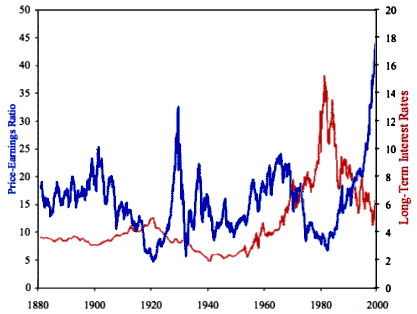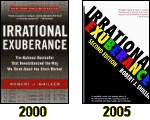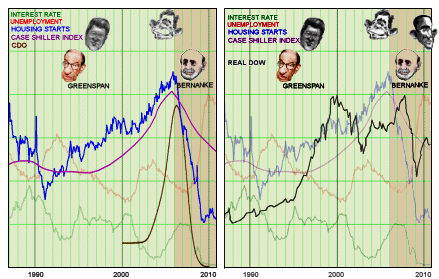But how do we know when irrational exuberance has unduly escalated asset values, which then become subject to unexpected and prolonged contractions as they have in Japan over the past decade? And how do we factor that assessment into monetary policy? We as central bankers need not be concerned if a collapsing financial asset bubble does not threaten to impair the real economy, its production, jobs, and price stability.
Immediately after he said this, the stock market in Tokyo, which was open as he gave this speech, fell sharply, and closed down 3%. Hong Kong fell 3%. Then markets in Frankfurt and London fell 4%. The stock market in the US fell 2% at the open of trade. The strong reaction of the markets to Greenspan’s seemingly harmless question was widely noted, and made the term irrational exuberance famous.
The term irrational exuberance became Greenspan’s most famous quote, out of all the millions of words he has uttered publicly. The term "irrational exuberance" is now often used to describe a heightened state of speculative fervor. It is less strong than other colorful terms such as "speculative mania" or "speculative orgy" which discredit themselves as overstating the case. I chose this phrase as the title for my book because many people know instantly from this title what this book is about.

When Wall Street analysts talk about the price-earnings ratio—the P/E ratio—they generally base their analysis on a very short-term measure of corporate earnings. They typically look at earnings over the past year or at forecasts of earnings over the coming year. They then divide the price of a company’s stock by this measure of earnings, to judge whether the stock is fairly valued. The same can be done for the market as a whole: the Standard & Poor 500 index, for instance, divided by the average earnings of the companies in the index.
Shiller and John Campbell, a former Shiller student and longtime Harvard professor who now runs Arrowstreet Capital, had come to believe that such measures were fatally flawed. Earnings over any given 12 months can fluctuate wildly, depending on whether the economy is booming or busting. Forecasts of earnings are even more problematic, given Wall Street’s unimpressive forecasting record. No P/E ratio based on only 12 months of earnings will tell you much about the long-term prospects of American companies, which is precisely what stock prices are meant to capture.So Shiller and Campbell did something that, on its face, did not make much sense. To get a better glimpse of the future, they looked further in the past. They compared stock prices at any given time with average corporate earnings over the previous ten years… Until Shiller and Campbell came along, long-term P/E ratios were virtually absent from public discussion.
Their version of the ratio entered the discussion, loudly, in December of 1996. They were both among a group of economists and stock market analysts invited to the Federal Reserve to speak with Greenspan, who was then its chairman. During their presentation, they distributed a handout containing a version of The Chart. Rather than simply showing their P/E ratio over time, this version showed the relationship between the ratio at a given time and the performance of stock prices over the next decade. The pattern was clear: the higher the ratio, the lower that future returns tended to be.
Even in late 1996, more than three years before stocks peaked, this pattern was foreboding. The P/E ratio was then above 25, higher than it had been at any time since 1929. Wall Street’s standard P/E ratios missed this development, because corporate earnings were also soaring at the time, making the ratio look almost normal. But earnings are highly cyclical. They rarely stay very high for very long. The Shiller-Campbell ratio showed that stock prices were now based on the idea that earnings had reached a new, permanent level. Otherwise, stock prices were headed for a fall. Investors, Shiller told Greenspan, had become irrational…
Greenspan listened without betraying his own views, and Shiller headed back to New Haven assuming that he hadn’t persuaded the chairman. Three days later, while driving his son to school, Shiller heard a radio report that stocks around the world had begun to drop. Investors were reacting to a speech Greenspan had given at a dinner in Washington the night before. "How do we know," he asked, "when irrational exuberance has unduly escalated asset values, which then become subject to unexpected and prolonged contractions as they have in Japan over the past decade?" After that one speech, however, Greenspan didn’t continue to sound the alarm.

 In 2000, Robert Shiller published his book, Irrational Exuberance, showing his 10 year P/E Chart and essentially predicting the dotcom’s coming collapse. As the dotcom stocks and the DOW fell, we had our next Recession. So after 5 years of prosperity with the Fed’s interest rates a little over 5%, Greenspan was in the position of responding to the Recession by lowering them – this time down to ~1%. But Robert Shiller wasn’t done yet. He began to use an index that he and others had developed to follow Home Values to look at something else that was looming on the horizon – that monster we now call the "housing bubble. In 2005, he added a chapter to his book predicting the collapse of this bubble in the near term. It burst in December 2005:
In 2000, Robert Shiller published his book, Irrational Exuberance, showing his 10 year P/E Chart and essentially predicting the dotcom’s coming collapse. As the dotcom stocks and the DOW fell, we had our next Recession. So after 5 years of prosperity with the Fed’s interest rates a little over 5%, Greenspan was in the position of responding to the Recession by lowering them – this time down to ~1%. But Robert Shiller wasn’t done yet. He began to use an index that he and others had developed to follow Home Values to look at something else that was looming on the horizon – that monster we now call the "housing bubble. In 2005, he added a chapter to his book predicting the collapse of this bubble in the near term. It burst in December 2005:
Challenging the Crowd in Whispers, Not Shouts
By ROBERT J. SHILLERNew York TimesNovember 1, 2008
ALAN GREENSPAN, the former Federal Reserve chairman, acknowledged in a Congressional hearing last month that he had made an “error” in assuming that the markets would properly regulate themselves, and added that he had no idea a financial disaster was in the making. What’s more, he said the Fed’s own computer models and economic experts simply “did not forecast” the current financial crisis. Mr. Greenspan’s comments may have left the impression that no one in the world could have predicted the crisis. Yet it is clear that well before home prices started falling in 2006, lots of people were worried about the housing boom and its potential for creating economic disaster. It’s just that the Fed did not take them very seriously.
For example, I clearly remember a taxi driver in Miami explaining to me years ago that the housing bubble there was getting crazy. With all the construction under way, which he pointed out as we drove along, he said that there would surely be a glut in the market and, eventually, a disaster.
But why weren’t the experts at the Fed saying such things? And why didn’t a consensus of economists at universities and other institutions warn that a crisis was on the way? The field of social psychology provides a possible answer. In his classic 1972 book, “Groupthink,” Irving L. Janis, the Yale psychologist, explained how panels of experts could make colossal mistakes. People on these panels, he said, are forever worrying about their personal relevance and effectiveness, and feel that if they deviate too far from the consensus, they will not be given a serious role. They self-censor personal doubts about the emerging group consensus if they cannot express these doubts in a formal way that conforms with apparent assumptions held by the group…
From my own experience on expert panels, I know firsthand the pressures that people — might I say mavericks? — may feel when questioning the group consensus. I was connected with the Federal Reserve System as a member the economic advisory panel of the Federal Reserve Bank of New York from 1990 until 2004, when the New York bank’s new president, Timothy F. Geithner, arrived. That panel advises the president of the New York bank, who, in turn, is vice chairman of the Federal Open Market Committee, which sets interest rates. In my position on the panel, I felt the need to use restraint. While I warned about the bubbles I believed were developing in the stock and housing markets, I did so very gently, and felt vulnerable expressing such quirky views. Deviating too far from consensus leaves one feeling potentially ostracized from the group, with the risk that one may be terminated…
In 2005, in the second edition of my book “Irrational Exuberance,” I stated clearly that a catastrophic collapse of the housing and stock markets could be on its way. I wrote that “significant further rises in these markets could lead, eventually, to even more significant declines,” and that this might “result in a substantial increase in the rate of personal bankruptcies, which could lead to a secondary string of bankruptcies of financial institutions as well,” and said that this could result in “another, possibly worldwide, recession.” I distinctly remember that, while writing this, I feared criticism for gratuitous alarmism. And indeed, such criticism came.
I gave talks in 2005 at both the Office of the Comptroller of the Currency and at the Federal Deposit Insurance Corporation, in which I argued that we were in the middle of a dangerous housing bubble. I urged these mortgage regulators to impose suitability requirements on mortgage lenders, to assure that the loans were appropriate for the people taking them. The reaction to this suggestion was roughly this: yes, some staff members had expressed such concerns, and yes, officials knew about the possibility that there was a bubble, but they weren’t taking any of us seriously…
Why do professional economists always seem to find that concerns with bubbles are overblown or unsubstantiated? I have wondered about this for years, and still do not quite have an answer. It must have something to do with the tool kit given to economists and perhaps even with the self-selection of those attracted to the technical, mathematical field of economics…
In addition, it seems that concerns about professional stature may blind us to the possibility that we are witnessing a market bubble. We all want to associate ourselves with dignified people and dignified ideas. Speculative bubbles, and those who study them, have been deemed undignified. In short, Mr. Janis’s insights seem right on the mark. People compete for stature, and the ideas often just tag along… Unless Mr. Greenspan was exceptionally insightful about social psychology, he may not have perceived that experts around him could have been subject to the same traps.
 Unlike Shiller, I’m not willing to give Greenspan much of a bye on this one. He dropped the ball too often – blathered Ayn Rand talk too often, suppressed good people like Brooksley Born, overshot his regulatory powers to keep Recessions brief, protected unregulated derivatives [a defenseless position], and didn’t listen to Robert Shiller. But I take Shiller’s point that it’s very hard to have heightened skepticism during good times. Greenspan may have warned us about irrational exuberance once, but he not only failed to act on it, he basked in its glory as long as it lasted. He was always in the news, on the television, giving speeches somewhere. He was called The Wizard and the Maestro and he was awarded the Presidential Medal of Freedom as he retired.Yet he made a cataclysmic error in mid-career that will linger throughout the rest of our lives. In short – Alan Greenspan blew it!…
Unlike Shiller, I’m not willing to give Greenspan much of a bye on this one. He dropped the ball too often – blathered Ayn Rand talk too often, suppressed good people like Brooksley Born, overshot his regulatory powers to keep Recessions brief, protected unregulated derivatives [a defenseless position], and didn’t listen to Robert Shiller. But I take Shiller’s point that it’s very hard to have heightened skepticism during good times. Greenspan may have warned us about irrational exuberance once, but he not only failed to act on it, he basked in its glory as long as it lasted. He was always in the news, on the television, giving speeches somewhere. He was called The Wizard and the Maestro and he was awarded the Presidential Medal of Freedom as he retired.Yet he made a cataclysmic error in mid-career that will linger throughout the rest of our lives. In short – Alan Greenspan blew it!…
Sorry, the comment form is closed at this time.